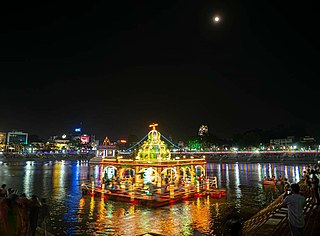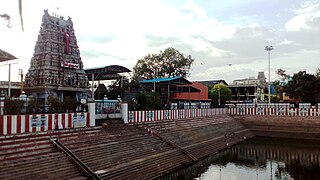
Mylapore, or Thirumayilai, is a neighbourhood in the central part of the city of Chennai, India. It is one of the oldest residential parts of the city. The locality is claimed to be the birthplace of the celebrated Tamil philosopher Valluvar, and the Hindu saint and philosopher, Peyalvar.

Adambakkam is a neighbourhood of Chennai, India. It is primarily a residential locality situated in South Chennai. Adambakkam area comes under Velachery taluk and Alandur taluk, Chennai District of Chennai Corporation. Adambakkam is surrounded by areas namely, Alandur in the North-West, Nanganallur in the West, Madipakkam in the South, Velachery in the East and Guindy in the North. Earlier, one part of Adambakkam was under the direct governance of Chennai Corporation. From October 2011 onwards, the entire area was merged with the Chennai Corporation. Upon completion of the MRTS extension line, the neighbourhood will be served by Adambakkam railway station. Its Proximity to commercial localities like Velachery, accessible railway stations, Metro Stations and road transport routes makes Adambakkam an ideal choice of location to live.

Koyambedu is a neighbourhood in Chennai, India. Situated in the western part of Chennai city, the Koyambedu area has become a major hub of activity in Chennai after the inauguration of the Koyambedu market in 1996 and the Chennai Mofussil Bus Terminus (CMBT) in 2002. The area is active round the clock owing to the movement of people and goods through the day, with uninterrupted transport facilities such as long-route buses, autos, share autos, vegetable goods carriers and so forth.

Thyagaraya Nagar, commonly known as T. Nagar, and historically known as East Mambalam, is a very affluent commercial and residential neighbourhood in Chennai, Tamil Nadu, India. It is surrounded by Nungambakkam in the North, Teynampet in the East, Nandanam in the South-East, C.I.T. Nagar in the South and West Mambalam and Kodambakkam in the West. The stretch between Duraiswamy Road and T. Nagar Bus Stand has some of the costliest real estates in Chennai. It was constructed between 1923 and 1925 by the Madras Presidency government of the Raja of Panagal as a part of town planning activities initiated according to the Madras Town Planning Act of 1920. The town was named after P. Thyagaraya Chetty. The streets, parks and localities in the new neighbourhood were named after important officials in the provincial government.

Tambaram is a city located within the Chennai Metropolitan Area in the Indian State of Tamil Nadu. The city is governed by Tambaram City Municipal Corporation.

Chromepet is a suburb located in the southern part of Chennai, India. It is situated around 22 km from the Chennai Central Railway Station and 4 km south of the Chennai International Airport on the Grand Southern Trunk. Formerly a part of Pallavaram Municipality, it is now governed by the Tambaram City Municipal Corporation.Neighbouring areas include Thirumudivakkam, Tambaram, and Pallavaram. The 200-feet road connects Chromepet with Thoraipakkam.
Virugambakkam is a residential neighbourhood of Chennai, Tamil Nadu, India. It is an important residential area of and is famous for its schools, market, residential colonies and residences of film artists. Virugambakkam had some of Chennai's oldest film studios.

Saidapet, also known as Saidai, is a neighbourhood in Chennai, India, situated in the northern banks of the Adyar River and serves as an entry point to Central Chennai. It is surrounded by West Mambalam in the North, C.I.T Nagar in the North-East, Nandanam in the East, Guindy in the South, Jafferkhanpet and Ashok Nagar in the North-West. The Saidapet Court, the only other court of judicature in Chennai city apart from the Madras High Court, and the Saidapet bus depot are located here. Prior to its incorporation in Madras city, Saidapet functioned as the administrative headquarters of Chingleput district. The neighbourhood is served by Saidapet railway station of the Chennai Suburban Railway Network.

Vadapalani is a neighbourhood in the city of Chennai in Tamil Nadu, India. It is known for its film studios and the Vadapalani Andavar Temple, which is an important pilgrimage centre. Situated in the western part of Chennai, Vadapalani is an important bus terminus on Arcot Road. Vadapalani is one of the busiest and densely populated areas in Chennai.

Madambakkam is a neighborhood in the city of Tambaram, situated within the Chennai Metropolitan Area, Tamil Nadu, India.
West Mambalam is a residential and commercial area in Chennai, India. It is known for its shops, bazaars and Hindu temples. It is bounded by Kodambakkam to the north and Saidapet to the south. T. Nagar and Nandanam stretch all along its eastern frontiers while Ashok Nagar lies to its west. The Ayodhya Mandapam is an important landmark.
Choolaimedu is a large residential and commercial locality in Chennai, Tamil Nadu, India. It borders Kodambakkam, Vadapalani, M.M.D.A. Colony, Aminjikarai, Mahalingapuram and Nungambakkam. Previously a part of Puliyur village, Kodambakkam, Choolaimedu has now become a hub for commercial interests and connects two of the busiest routes in Chennai, namely Arcot Road and Nelson Manickam Road.
Ashok Nagar is a residential locality situated at the southern part of Chennai, Tamil Nadu, India. It was established in 1964. At the heart of this colony, stands the Ashok Pillar. This four lion head stump, resembles the one erected by king Ashoka during the 3rd century BCE at Sanchi.
Padi is a locality and neighbourhood in the city of Chennai, India. It was named as Thiruvaaipadi and Later called as Padi short form of Thiruvaaipadi, Sundarar, came to Padi and sang songs in the Lord Shiva Temple. Padi exactly 13 km from the city's Kilometer Zero is a latest included part of the city. MTH Road, now unofficially known as the CTH Road, passes through Padi. Padi is basically an industrial area and its infrastructure and living conditions have made this place popular among the working class. Arulmigu Thiruvalithayam Temple in Padi is one of the famous Guru Bhagawan temples in Chennai. This temple is under the control of Hindu Aranilayathurai. Every year Thai Kirthigai is one of the big festival in Padi. Another nearby temple is the Padavattamman Temple.

AVM Productions is an Indian film production studio founded by A. V. Meiyappa Chettiar. It is the oldest studio in India. The filming studios are located in Vadapalani, Chennai. It has produced over 300 films in Tamil, Telugu, Kannada, Malayalam and Hindi cinema. AVM has introduced numerous actors in Southern industries, some of the prominent actors are Superstar Rajnikanth, Sivaji Ganesan, Rajkumar, S. S. Rajendran, Vyjayanthimala, Kamal Haasan and many more. The AVM Studios besides the shooting floors, has recording, dubbing and a preview theatre. The complex also houses facilities for production and post production processing.
The article speaks about the many print, television and radio networks that dominate Chennai city's mass media market.

Avichi Meiyappa Chettiar, also known as A. V. Meiyappan, A. V. Meiyappa Chettiar or AVM, was an Indian film producer, director and philanthropist who established AVM Productions in Vadapalani, Chennai. He is widely regarded as one of the pioneers of Tamil cinema, and one of three movie moguls of the South Indian film industry along with S. S. Vasan and L. V. Prasad. His production company AVM Productions is the only production company in Kollywood to run successfully for five decades and three generations.
This is a timeline of major events in the history of Chennai.

Vadapalani is an elevated metro station on the South-East Corridor of the Green Line of Chennai Metro in Chennai, India. This station serves the neighbourhoods of Vadapalani and Kodambakkam and is one of the major stations on the Koyambedu-Alandur stretch and became operational by early 2015.
Central Chennai is the part of Chennai city between the Coovum River and the Adyar River. While mostly grouped under South Chennai, Central Chennai is a term which has gained currency in recent times due to the rapid expansion of the city southwards. Covering the eastern neighbourhoods of Royapettah, Chepauk, Teynampet, Alwarpet, Mylapore, Triplicane and Mandaveli and the western neighbourhoods of Nungambakkam, Kodambakkam, Vadapalani, Virugambakkam, Valasaravakkam, Mambalam, T. Nagar, Nandanam and Saidapet, Central Chennai is largely upper class-upper middle class. The eastern part is largely upper class with two of the costliest pieces of real estate - the Boat Club Road and Poes Garden being located here while the western part is mainly middle class. Kodambakkam is the location of the Tamil film industry or Kollywood.

















